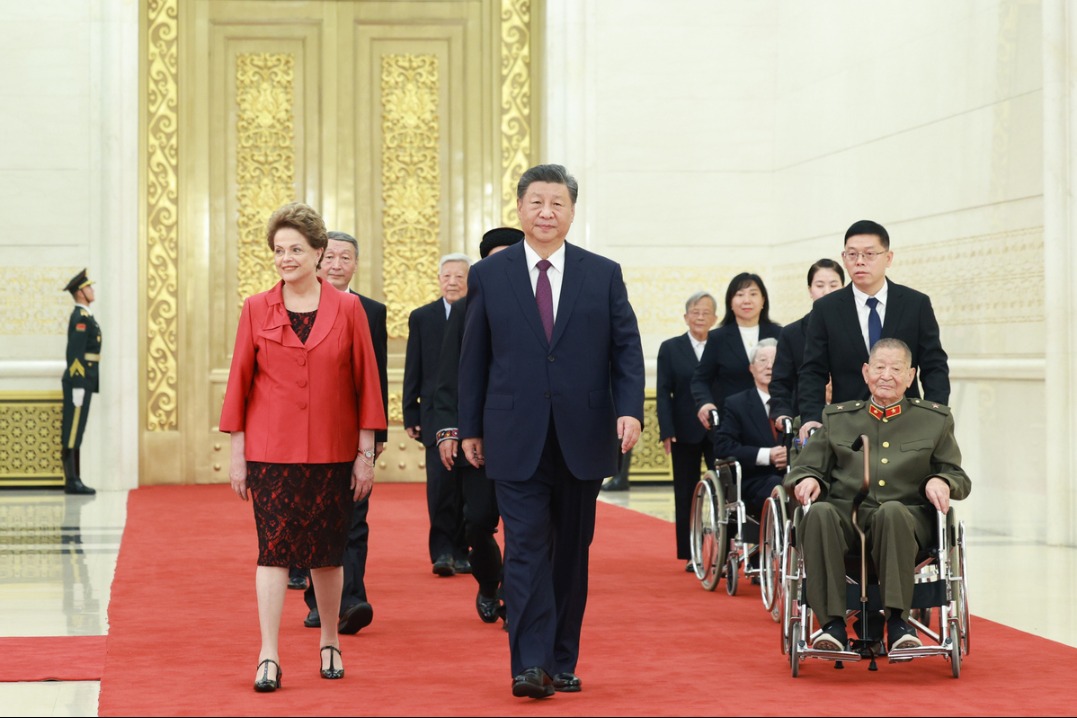Autonomous driving shifts into high gear in China
Xinhua | Updated: 2024-08-13 11:09

BEIJING - Buckle up, touch a screen, and off you go -- with no hands on the wheel.
Taking a ride in one of the world's most cutting-edge robotaxis is becoming almost effortless in Beijing E-Town, a national-level economic-technological development area in the Chinese capital.
"Some might feel nervous when trying these fully self-driving taxis for the first time. But in my personal experience, after three or four minutes of chat in the seats, they would forget they were in a driverless car," said Zhang Ning, vice-president of Chinese autonomous driving startup Pony.ai and head of its Beijing R&D center.
Outside the science fiction-like cab is an even more exciting bigger picture. Galvanized by growing technology prowess, accommodating regulation and investor enthusiasm, the autonomous driving industry is charging ahead toward large-scale commercial use with China revving up efforts to foster tech-intensive new growth engines.
Entering fast lane
Nearly 100 Pony.ai robotaxis are now available in a 160 square-km designated autonomous driving zone in Beijing E-Town, offering paid services for anyone, if they like, with just a few clicks on a mobile app.
The company, a rival to Alphabet's self-driving car unit Waymo, aims to increase the scale of its single-city robotaxi fleet to 10 times this number by either 2025 or 2026, Zhang told Xinhua in an interview.
"We've now come to the stage where it is possible to reduce costs on a larger scale of commercialization," he said. "As long as the robotaxi fleet reaches above 1,000 in one city, we will be able to break even in operation."
With around 250 robotaxis deployed in China's four first-tier cities, namely Beijing, Shanghai, Guangzhou and Shenzhen, Pony.ai is teaming up with Japanese carmaker Toyota to roll out new-generation vehicles en masse.
These seventh-generation models will integrate autonomous driving technology during, rather than after, the car manufacturing process, making production more efficient.
This acceleration extends beyond the passenger transport scenario. In addition to its current around 200 fuel-driven robotrucks nationwide, Pony.ai is expected to roll out electric models to scale up autonomous driving in the field of cargo transport.
Describing autonomous driving as "a killer application" of artificial intelligence (AI), Zhang is upbeat about the prospects of this nascent industry, noting that it will catalyze the development of a whole AI industrial chain that incorporates such links as transport, energy and cloud computing.
Both the robotaxis and robotrucks produced by Pony.ai are based on L4 autonomy, which means the vehicles can drive themselves in most conditions without a human backup driver.
Autonomous driving is categorized from Level 0 to Level 5. The higher the level, the more advanced and intelligent the technology.
Listing AI as one of the strategic industries to be promoted through better policy and governance in the country's latest reform plan to advance modernization, China has been at the forefront of autonomous driving development.
The country first piloted robotaxis without safety operators in the cities of Wuhan and Chongqing in 2022. Last March, China approved the commercial operation of fully autonomous driving services in Beijing. By the end of 2023, over 30 Chinese cities had issued road test licenses for autonomous driving.
Global consulting firm McKinsey & Company has forecast that China will become the world's largest market for self-driving vehicles, with revenue from such vehicles and mobility services exceeding $500 billion by 2030.
"Five or six years ago, most people would doubt if autonomous driving could take root in China. There are no such doubts now," Zhang said.
Driving force
Technological progress is at the heart of the industry's advance, making driverless vehicles safer, cheaper, cleaner and more comfortable than traditional ones.
The safety level of autonomous driving is 10 times that of manned driving, according to Zhang, who noted that ensuring safety, efficiency and riding comfort will be a focus of his company's technology input as it speeds up commercialization.
Pony.ai had accumulated a total of 3.5 million km in global fully driverless testing as of May this year, compared with 200,000-300,000 km that a person could amass for a whole lifetime in general if not a long-distance commuter or a professional driver.
There is abundant demand for driverless vehicles in China, where 90 percent of traffic accidents are caused by human errors, according to official data. The riding experience in a clean cab without unwanted interaction with drivers is also a plus for many passengers. Self-driving trucks could make long-distance cargo transport less exhausting and reduce the demand for truck drivers, which is already faced with an insufficient supply.
"It takes two drivers to work on shifts to carry cargo from Beijing to Guangzhou, a 2,400 km journey, on a conventional truck. With these self-driving trucks, it only takes one safety inspector like me," said 31-year-old robotruck driver Huo Kangtian. "It's a much less tiresome job."
Investor interest has fueled the industry's upgrade. Pony.ai, for instance, has secured more than $1.4 billion of financing from both domestic and foreign investors since 2017. The company was valued at $8.5 billion as of October last year.
The investment environment for the industry has been improving since last year, despite fluctuations in previous years, according to the company.
Government support is also a key driving force. The opening of the designated autonomous driving demonstration zone in Beijing is pivotal for the initial development of startups like Pony.ai, Zhang revealed. Local authorities plan to expand this area to cover 600 square km and to extend it closer to the city center in the future.
"The central and local governments in China rank first in the world in terms of their openness and understanding of autonomous driving, or are at least on par with the United States, to be modest," said Li Hengyu, vice-president of Pony.ai and head of its robotruck business unit.
Autonomous driving is a case in point as to how China better leverages the government role to overhaul its economic structure and forge new growth impetus by cultivating emerging high-tech industries, which usually are highly uncertain in terms of business prospects and demand long-term input.
By late February 2024, China boasted more than 20 cities that had launched policies supporting autonomous driving tests, with over 60 enterprises having obtained autonomous driving test licenses.
Five ministries, including the Ministry of Industry and Information Technology and the Ministry of Transport, jointly issued a notice in July to identify 20 cities or urban agglomerations, including Beijing, Shanghai and Guangzhou, as pilot areas for the application of intelligent network integrating vehicles, roads and cloud.
"As China takes the lead in supporting autonomous driving, a lot of developed countries are coming to China to learn how our industry is governed here. It used to be the other way around," Zhang said.
With rivalry between China and the United States set to heat up even further in the future, Zhang has confidence in the Chinese domestic industry's prospects for competing in the global arena.
"If we can generate profits in China, which has much more complicated traffic surroundings than many other countries, we will almost certainly nail it in other markets," said Zhang.
The company now provides self-driving products and services for such overseas regions as the Republic of Korea, Luxembourg and Saudi Arabia.
Looking ahead, challenges remain in terms of technology improvement and regulation.
"We hope there could be more roads, cities and regions to be opened for the testing and operation of driverless cars, and more unified national-level regulation of the industry," Zhang said.
























